Table of Contents
Overview
We have seen that the end of Cold War left the US without any serious rival in the world. The era since then has been described as a period of US dominance or a unipolar world. In this chapter, we try to understand the nature, extent and limits of this dominance. We begin by narrating the story of the rise of the new world order from the First Gulf War to the US-led invasion of Iraq. We then pause to understand the nature of US domination with the help of the concept of ‘hegemony’. After exploring the political, economic and cultural aspects of US hegemony, we assess India’s policy options in dealing with the US. Finally, we turn to see if there are challenges to this hegemony and whether it can be overcome.
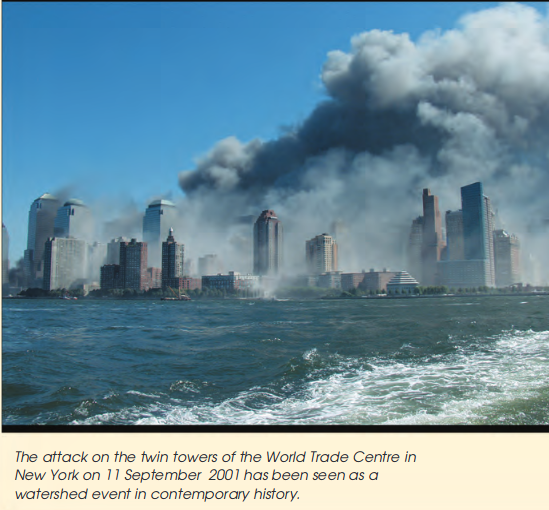
Ayesha, Jabu and Andrei
Ayesha was doing very well in her studies at a high school in the outskirts of Baghdad, and was planning to study medicine in university. She lost a leg in 2003 when a missile slammed into an air raid shelter in which she was hiding with her friends. Now she is learning to walk all over again. She still plans to become a doctor, but only after the foreign armies leave her country.
Jabu is a talented young artist who lives in Durban, South Africa. His paintings are heavily influenced by traditional tribal art forms. He wants to go to art school and later open his own studio. However, his father wants him to study for an MBA and then join the family business. The business is not doing too well; Jabu’s father feels that with an MBA degree, Jabu will be able to make the family business profitable.
Andrei is a young man living in Perth, Australia. His parents are immigrants from Russia. His mother gets very angry every time Andrei puts on blue jeans to go to church. She wants him to look respectable in church. Andrei tells his mother that jeans are “cool”, that they give him the sense of freedom. Andrei’s father reminds his wife how they too used to wear jeans when they were youngsters in Leningrad, and for the same reason that their son now invokes.

I’m glad I did not opt for the Science subjects. Or else I too would have been a victim of US hegemony. Can you think how and why?
Andrei has had an argument with his mother. Jabu may be forced to study a subject that he has no interest in. In contrast, Ayesha has lost her leg and is lucky to be alive. How can we even discuss their problems in the same breath? We can, and must, do so. As we shall see in this chapter, all three have been, in different ways, affected by US hegemony. We will meet Ayesha, Jabu and Andrei again. But let us first understand how US hegemony began and how it operates in the world today.
We will follow the popular usage of the word ‘America’ to refer to the United States of America. But it may be useful to remind ourselves that the expression America covers the two continents of North and South America and that the US is only one of the countries of the American continent. Thus, the use of the word America solely for the US is already a sign of the US hegemony that we seek to understand in this chapter.
Beginning of the ‘New World Order’
The sudden collapse of the Soviet Union took everyone by surprise. While one of the two superpowers ceased to exist, the other remained with all its powers intact, even enhanced. Thus, it would appear that the US hegemony began in 1991 after Soviet power disappeared from the international scene. This is largely correct, but we need to keep in mind two riders to this. First, as we shall see in this chapter, some aspects of US hegemony did not emerge in 1991 but in fact go back to the end of the Second World War in 1945. Second, the US did not start behaving like a hegemonic power right from 1991; it became clear much later that the world was in fact living in a period of hegemony. Let us therefore look at this process by which US hegemony got established more closely.
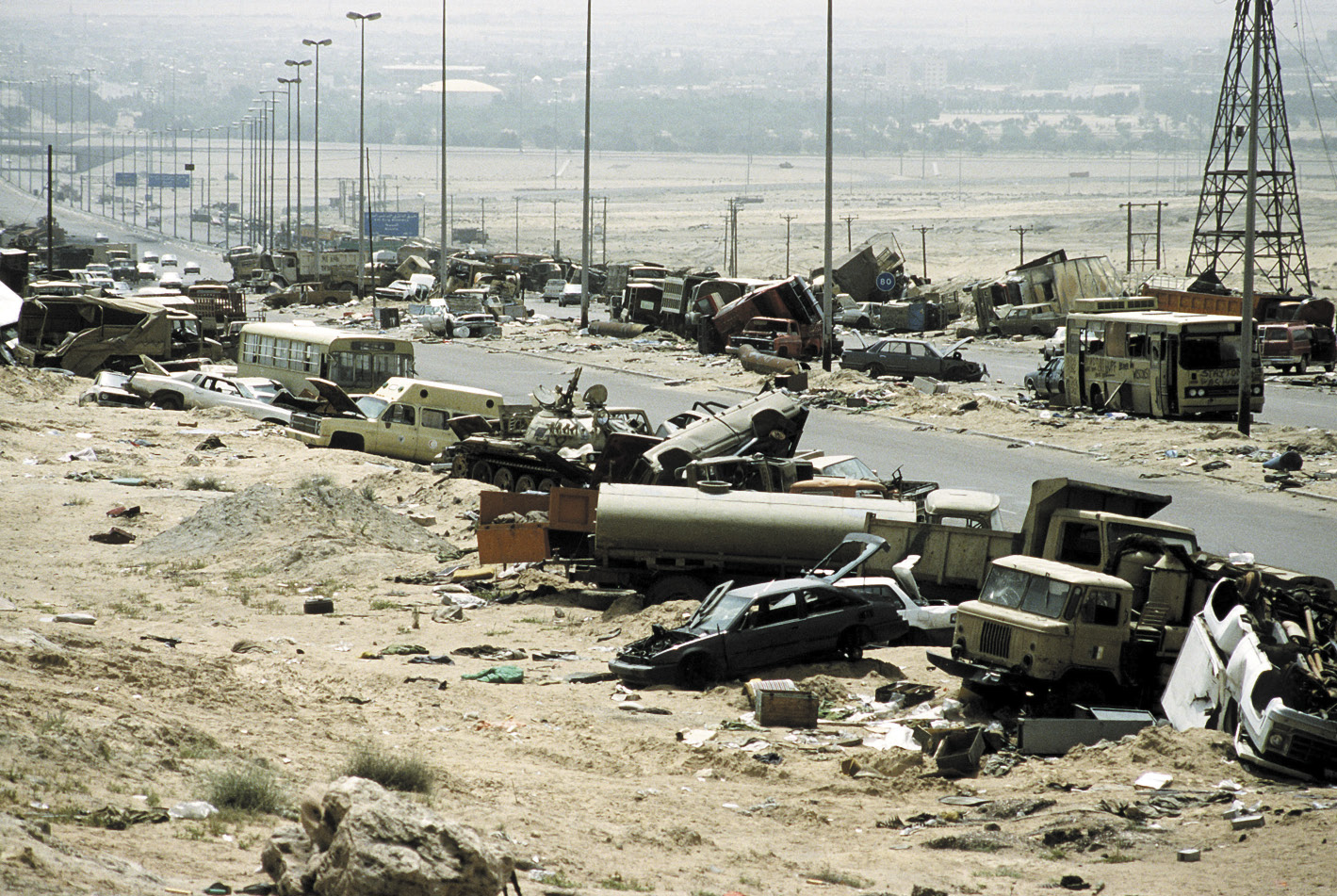
This picture of burned and broken vehicles was taken on the ‘Highway of Death’, a road between Kuwait and Basra, on which the retreating Iraqi army was attacked by American aircraft during the First Gulf War in February 1991. Some commentators have suggested that the US forces deliberately bombed this stretch of highway where fleeing and ‘out of combat’ Iraqi soldiers were stuck in a frenzied traffic jam and that the victims included Kuwaiti prisoners and hostages and Palestinian civilian refugees. Many observers have called it a ‘war crime’ and a violation of the Geneva Convention.
In August 1990, Iraq invaded Kuwait, rapidly occupying and subsequently annexing it. After a series of diplomatic attempts failed at convincing Iraq to quit its aggression, the United Nations mandated the liberation of Kuwait by force. For the UN, this was a dramatic decision after years of deadlock during the Cold War. The US President George H.W. Bush hailed the emergence of a ‘new world order’.
A massive coalition force of 660,000 troops from 34 countries fought against Iraq and defeated it in what came to be known as the First Gulf War. However, the UN operation, which was called ‘Operation Desert Storm’, was overwhelmingly American. An American general, Norman Schwarzkopf, led the UN coalition and nearly 75 per cent of the coalition forces were from the US. Although the Iraqi President, Saddam Hussein, had promised “the mother of all battles”, the Iraqi forces were quickly defeated and forced to withdraw from Kuwait.
The First Gulf War revealed the vast technological gap that had opened up between the US military capability and that of other states. The highly publicised use of so-called ‘smart bombs’ by the US led some observers to call this a ‘computer war’. Widespread television coverage also made it a ‘video game war’, with viewers around the world watching the destruction of Iraqi forces live on TV in the comfort of their living rooms.
Incredibly, the US may actually have made a profit from the war. According to many reports, the US received more money from countries like Germany, Japan and Saudi Arabia than it had spent on the war.

Is it true that the US has never fought a war on its own land? Doesn’t that make it easy for Americans to get into military adventures?
The Clinton years
Despite winning the First Gulf War, George H.W. Bush lost the US presidential elections of 1992 to William Jefferson (Bill) Clinton of the Democratic Party, who had campaigned on domestic rather than foreign policy issues. Bill Clinton won again in 1996 and thus remained the president of the US for eight years. During the Clinton years, it often seemed that the US had withdrawn into its internal affairs and was not fully engaged in world politics. In foreign policy, the Clinton government tended to focus on ‘soft issues’ like democracy promotion, climate change and world trade rather than on the ‘hard politics’ of military power and security.
Nevertheless, the US on occasion did show its readiness to use military power even during the Clinton years. The most important episode occurred in 1999, in response to Yugoslavian actions against the predominantly Albanian population in the province of Kosovo. The air forces of the NATO countries, led by the US, bombarded targets around Yugoslavia for well over two months, forcing the downfall of the government of Slobodan Milosevic and the stationing of a NATO force in Kosovo.
Another significant US military action during the Clinton years was in response to the bombing of the US embassies in Nairobi, Kenya and Dar-es-Salaam, Tanzania in 1998. These bombings were attributed to Al-Qaeda, a terrorist organisation strongly influenced by extremist Islamist ideas. Within a few days of this bombing, President Clinton ordered Operation Infinite Reach, a series of cruise missile strikes on Al-Qaeda terrorist targets in Sudan and Afghanistan. The US did not bother about the UN sanction or provisions of international law in this regard. It was alleged that some of the targets were civilian facilities unconnected to terrorism. In retrospect, this was merely the beginning.

This is ridiculous! Does it mean that Sri Lanka can drop a missile on Paris if it suspects that some of the LTTE militants are hiding there?
9/11 and the ‘Global War on Terror’
On 11 September 2001, nineteen hijackers hailing from a number of Arab countries took control of four American commercial aircraft shortly after takeoff and flew them into important buildings in the US. One airliner each crashed into the North and South Towers of the World Trade Centre in New York. A third aircraft crashed into the Pentagon building in Arlington, Virginia, where the US Defence Department is headquartered. The fourth aircraft, presumably bound for the Capitol building of the US Congress, came down in a field in Pennsylvania. The attacks have come to be known as “9/11”. (In America the convention is to write the month first, followed by the date; hence the short form ‘9/11’ instead of ‘11/9’ as we would write in India).
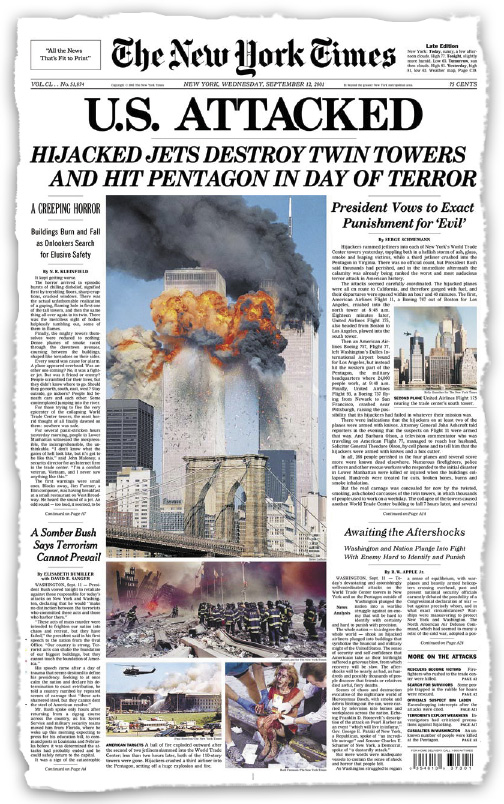
This is how the New York Times reported 9/11 in its edition the following morning
The attacks killed nearly three thousand persons. In terms of their shocking effect on Americans, they have been compared to the British burning of Washington, DC in 1814 and the Japanese attack on Pearl Harbour in 1941. However, in terms of loss of life, 9/11 was the most severe attack on US soil since the founding of the country in 1776.
The US response to 9/11 was swift and ferocious. Clinton had been succeeded in the US presidency by George W. Bush of the Republican Party, son of the earlier President George H. W. Bush. Unlike Clinton, Bush had a much harder view of US interests and of the means by which to advance them. As a part of its ‘Global War on Terror’, the US launched ‘Operation Enduring Freedom’ against all those suspected to be behind this attack, mainly Al-Qaeda and the Taliban regime in Afghanistan. The Taliban regime was easily overthrown, but remnants of the Taliban and Al-Qaeda have remained potent, as is clear from the number of terrorist attacks launched by them against Western targets since.
The US forces made arrests all over the world, often without the knowledge of the government of the persons being arrested, transported these persons across countries and detained them in secret prisons. Some of them were brought to Guantanamo Bay, a US Naval base in Cuba, where the prisoners did not enjoy the protection of international law or the law of their own country or that of the US. Even the UN representatives were not allowed to meet these prisoners.

Do they also have political dynasties in the US? Or was this the only exception?
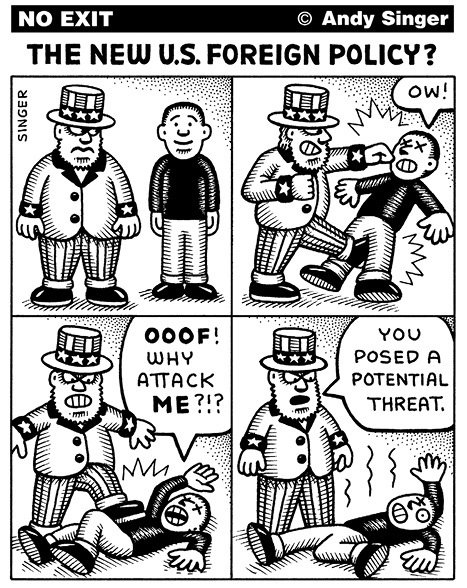
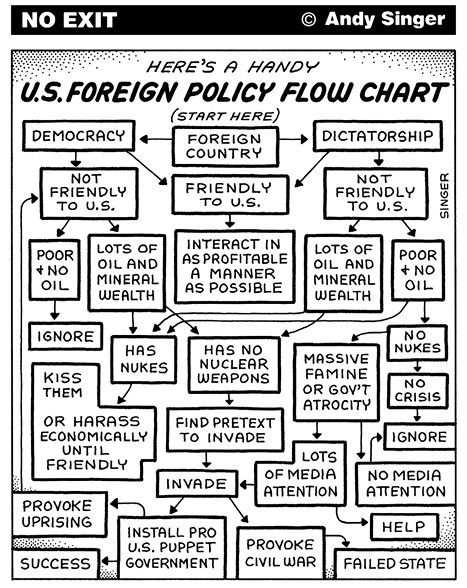
Suppose you are the Secretary of State in the US (their equivalent of our Minister of External Affairs).How would you react in a press conference to these cartoons?
The Iraq invasion
On 19 March 2003, the US launched its invasion of Iraq under the codename ‘Operation Iraqi Freedom’. More than forty other countries joined in the US-led ‘coalition of the willing’ after the UN refused to give its mandate to the invasion. The ostensible purpose of the invasion was to prevent Iraq from developing weapons of mass destruction (WMD). Since no evidence of WMD has been unearthed in Iraq, it is speculated that the invasion was motivated by other objectives, such as controlling Iraqi oilfields and installing a regime friendly to the US.
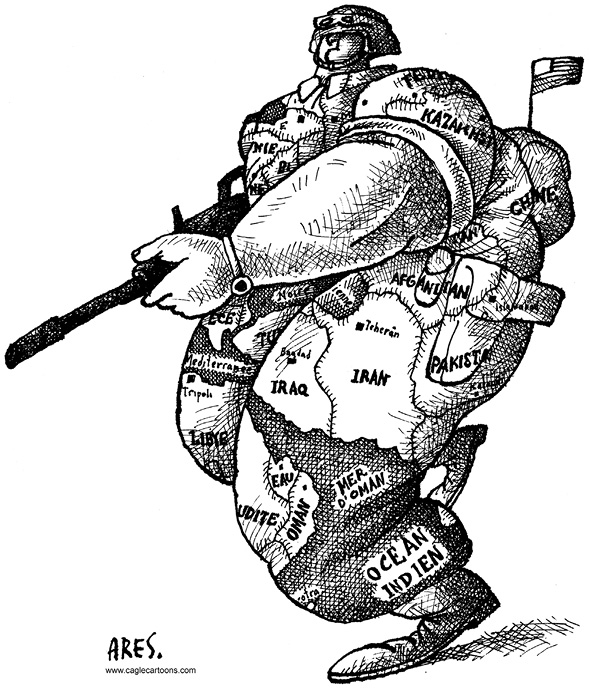
Soldier World Map
[Map of Post-Soviet Countries]
Although the government of Saddam Hussein fell swiftly, the US has not been able to ‘pacify’ Iraq. Instead, a full-fledged insurgency against US occupation was ignited in Iraq. While the US has lost over 3,000 military personnel in the war, Iraqi casualties are very much higher. It is conservatively estimated that 50,000 Iraqi civilians have been killed since the US-led invasion. It is now widely recognised that the US invasion of Iraq was, in some crucial respects, both a military and political failure.
Lets Do It
List the post-Cold War conflicts/wars in which the US played a critical role.
What does hegemony mean?
Politics is about power. Just as individuals want to gain and retain power, groups too want to gain and retain power. We routinely talk of someone becoming powerful or someone doing something for power. In the case of world politics too, countries and groups of countries are engaged in constantly trying to gain and retain power. This power is in the form of military domination, economic power, political clout and cultural superiority.
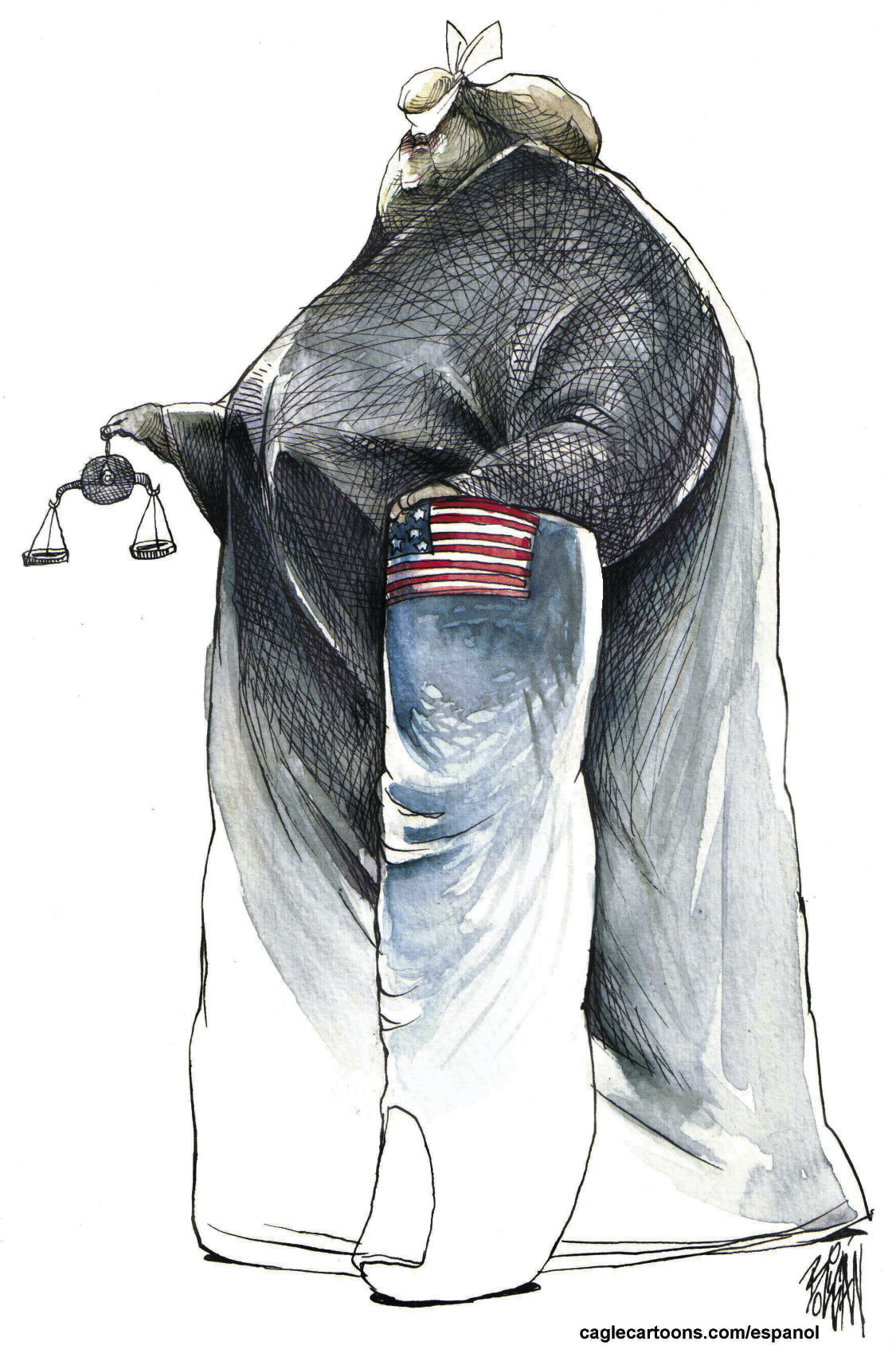
Entitled ‘Under US Thumb’, this cartoon captures ourcommonsensical understanding of what hegemony means.What does this cartoon say about the nature of US hegemony?Which part of the world is the cartoonist talking about?
Therefore, if we wanted to understand world politics, it is necessary that we understand the distribution of power among the countries of the world. For instance, during the years of the Cold War (1945-91) power was divided between the two groups of countries, and the US and the Soviet Union represented the two ‘camps’ or centres of power in international politics during that period. The collapse of the Soviet Union left the world with only a single power, the United States of America. Sometimes, the international system dominated by a sole superpower, or hyper-power, is called a ‘unipolar’ system. This appears to be a misapplication of the idea of ‘pole’ derived from physics. It may be more appropriate to describe an international system with only one centre of power by the term ‘hegemony’.

Why use suchcomplicated words like hegemony? In my town they call it dadagiri. Isn’t that better?
We can identify three very different understandings of what hegemony is. Let us examine each of these meanings of hegemony and relate them to contemporary international politics.
Hegemony as hard power
The roots of the word hegemony lie in classical Greek. The word implies the leadership or predominance of one state, and was originally used to denote the preponderant position of Athens vis-à-vis the other city-states of ancient Greece. Thus, the first meaning of hegemony relates to the relations, patterns and balances of military capability between states. It is this notion of hegemony as military preponderance that is especially germane to the current position and role of the US in world politics. Do you remember Ayesha, who lost her leg in an American missile attack? It is hard power hegemony that has broken Ayesha’s body, if not her spirit.

Source: http://www.c6f.navy.mil/about/area-responsibility
Note: The representation of boundaries is not necessarily authoritative.
The bedrock of contemporary US power lies in the overwhelming superiority of its military power. American military dominance today is both absolute and relative. In absolute terms, the US today has military capabilities that can reach any point on the planet accurately, lethally and in real time, thereby crippling the adversary while its own forces are sheltered to the maximum extent possible from the dangers of war.
But even more awesome than the absolute capabilities of the US is the fact that no other power today can remotely match them. The US today spends more on its military capability than the next 12 powers combined. Furthermore, a large chunk of the Pentagon’s budget goes into military research and development, or, in other words, technology. Thus, the military dominance of the US is not just based on higher military spending, but on a qualitative gap, a technological chasm that no other power can at present conceivably span.
Most armed forces in the world divide their areas of operation into various ‘commands’ which are assigned to different commanders. This map depicts the areas of responsibility of the Six Commands of the US armed forces. It shows that the commands of the US military are not limited to the area of the United States; it extends to include the whole world. What does this map tell us about the military power of the US?
Undoubtedly, the US invasion of Iraq reveals several American vulnerabilities. The US has not been able to force the Iraqi people into submitting to the occupation forces of the US-led coalition. To fully understand the nature of American weakness, however, we need to have a historical perspective. Imperial powers through history have used military forces to accomplish only four tasks: to conquer, deter, punish and police. As the Iraq invasion shows, the American capacity to conquer is formidable. Similarly, the US capability to deter and to punish is self-evident. Where US military capability has thus far been shown to have serious weaknesses is in policing an occupied territory.
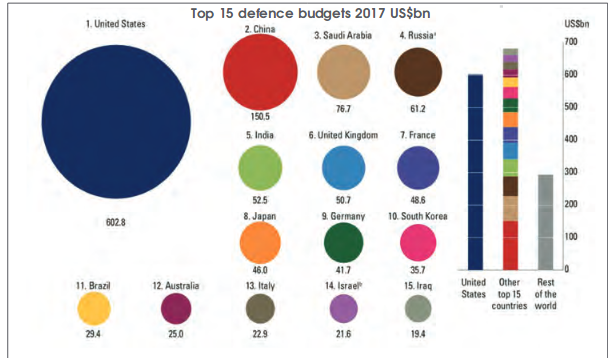
Source: The Military Balance 2018 (International Institute for Strategic Studies, London)
The US today spends more on its military capability than the next 12 powers combined.
As you can see here, most of the other countries that are big military spenders are USfriends and allies. Thus, balancing US power is not a feasible strategy today
Hegemony as structural power
The second notion of hegemony isvery different from the first. Itemerges from a particularunderstanding of the worldeconomy. The basic idea is thatan open world economy requiresa hegemon or dominant power tosupport its creation and existence. The hegemon must possess both the ability and thedesire to establish certain normsfor order and must sustain theglobal structure. The hegemonusually does this to its own advantage but often to its relativedetriment, as its competitors takeadvantage of the openness of the world economy without paying thecosts of maintaining its openness.
Hegemony in this second sense is reflected in the role played by the US in providing global public goods. By public goods we mean those goods that can be consumed by one person without reducing the amount of the good available for someone else. Fresh air and roads are examples of public goods. In the context of the world economy, the best examples of a global public good are sea-lanes of communication (SLOCs), the sea routes commonly used by merchant ships. Free trade in an open world economy would not be possible without open SLOCs. It is the naval power of the hegemon that underwrites the law of the sea and ensures freedom of navigation in international waters. Since the decline of British naval power after the Second World War, the multi-oceanic US Navy has played this role.
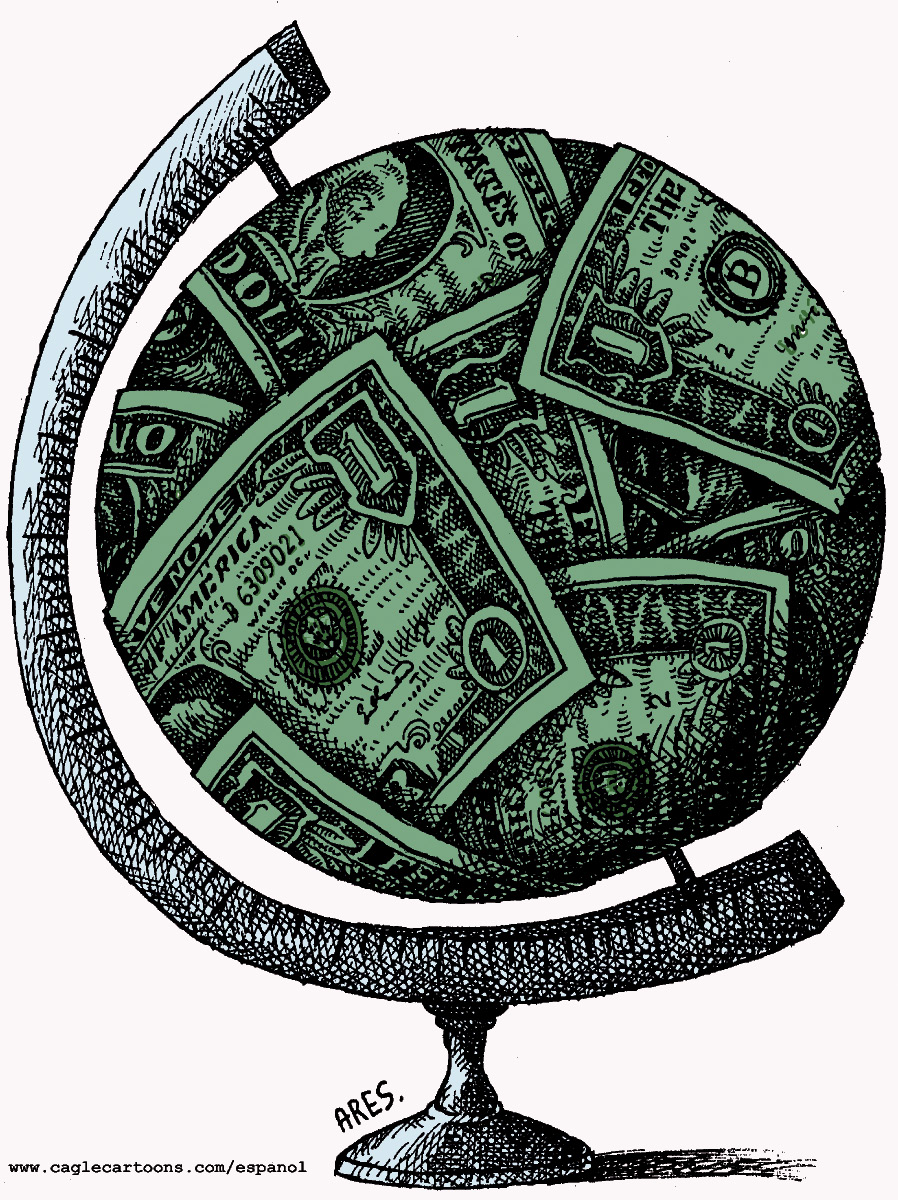
Dollar World
Another example of a global public good is the Internet. Although it is seen today as making the virtual world of the World Wide Web possible, we should not forget that the Internet is the direct outcome of a US military research project that began in 1950. Even today, the Internet relies on a global network of satellites, most of which are owned by the US government.
As we know, the US is present in all parts of the world, in all sectors of the world economy and in all areas of technology. The US share of the world economy remains an enormous 21 per cent.
The US also accounts for 15 per cent of world trade, if intra-European Union trade is included in world trade data. There is not a single sector of the world economy in which an American firm does not feature in the “top three” list.

How can this country be so rich? I see so many poor people here. Most of them are non-White.
It is important to remember that the economic preponderance of the US is inseparable from its structural power, which is the power to shape the global economy in a particular way. After all, the Bretton Woods system, set up by the US after the Second World War, still constitutes the basic structure of the world economy. Thus, we can regard the World Bank, International Monetary Fund (IMF) and World Trade Organisation (WTO) as the products of American hegemony.
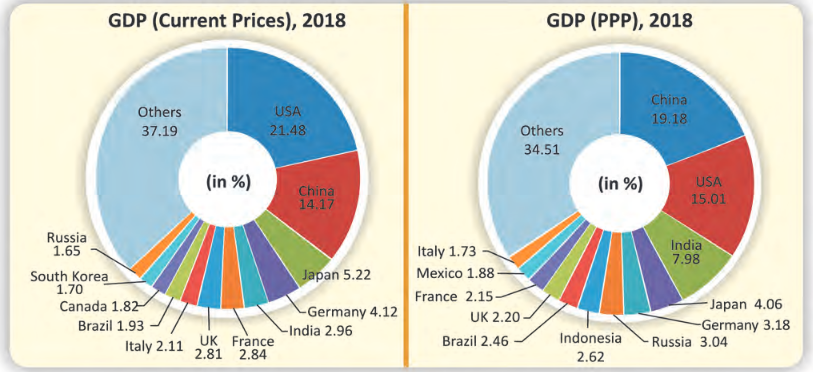
he American economy is the largest in the world, but unlike in the sphere of military power,the US faces credible competitors in the world economy. This becomes even clearer if weconsider the world economy in Purchasing Power Parity (PPP) terms as in the graphic on theright. PPP is what a nation’s currency actually buys in goods and services.
A classic example of the structural power of the US is the academic degree called the Master’s in Business Administration (MBA). The idea that business is a profession that depends upon skills that can be taught in a university is uniquely American. The first business school in the world, the Wharton School at the University of Pennsylvania, was established in 1881. The first MBA courses were initiated around 1900. The first MBA course outside the US was established only in 1950. Today, there is no country in the world in which the MBA is not a prestigious academic degree. This takes us back to our South African friend Jabu. Structural hegemony explains why Jabu’s father is insisting that his son gives up painting and studies for the MBA instead.

If I had opted for theScience subjectsI would have to sit forthe entrance exams tomedical orengineering college.That would meancompeting with somany others who wishto become doctors orengineers so as to goto the US.
Hegemony as soft power
It would however be a mistake to see US hegemony in purely military and economic terms without considering the ideological or the cultural dimension of US hegemony. This third sense of hegemony is about the capacity to ‘manufacture consent’. Here, hegemony implies class ascendancy in the social, political and particularly ideological spheres. Hegemony arises when the dominant class or country can win the consent of dominated classes, by persuading the dominated classes to view the world in a manner favourable to the ascendancy of the dominant class. Adapted to the field of world politics, this notion of hegemony suggests that a dominant power deploys not only military power but also ideological resources to shape the behaviour of competing and lesser powers. The behaviour of the weaker countries is influenced in ways that favour the interests of the most powerful country, in particular its desire to remain pre-eminent. Consent, in other words, goes hand-in-hand with, and is often more effective than, coercion.
The predominance of the US in the world today is based not only on its military power and economic prowess, but also on its cultural presence. Whether we choose to recognise the fact or not, all ideas of the good life and personal success, most of the dreams of individuals and societies across the globe, are dreams churned out by practices prevailing in twentieth-century America. America is the most seductive, and in this sense the most powerful, culture on earth. This attribute is called ‘soft power’: the ability to persuade rather than coerce. Over time we get so used to hegemony that we hardly notice it, any more than we notice the rivers, birds, and trees around us.
You couldn’t have forgotten Andrei and his ‘cool’ pair of blue jeans. When his parents were youngsters in the Soviet Union, blue jeans were the ultimate symbol of ‘liberation’ for their generation. Young men and women often spent over a year’s salary to buy blue jeans from foreign tourists on the black market. Somehow, for an entire Soviet generation blue jeans came to represent aspirations of the ‘good life’ that were not available in their own country.

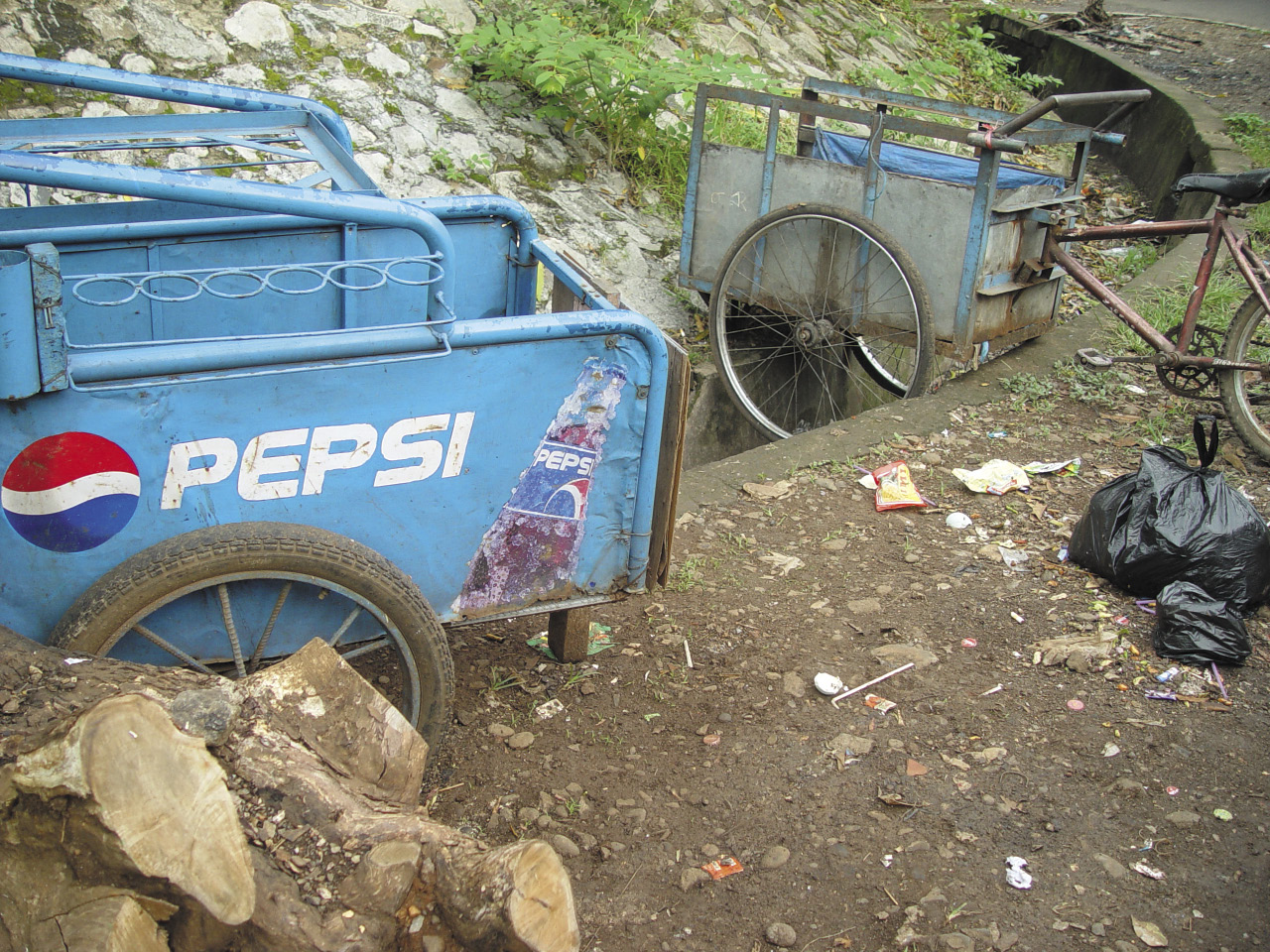

All these images are from Jakarta in Indonesia. Identify elements of US hegemony in each of these photographs. Can you identify similar elements on your way back from school to home?

That is strange! I never think of the US when buying jeans for myself. How can I still be a victim of US hegemony?
All these images are from Jakarta inIndonesia. Identify elements of UShegemony in each of thesephotographs. Can you identify similarelements on your way back fromschool to home?
During the Cold War, the US found it difficult to score victories against the Soviet Union in the realm of hard power. It was in the area of structural power and soft power that the US scored notable victories. Although the Soviet centrally-planned economy provided an alternate model of internal economic organisation, the world economy throughout the Cold War years remained a world capitalist economy. But it was in the area of soft power that the US was ultimately triumphant. As the example of blue jeans in the Soviet Union clearly shows, the US was able to engineer a generational divide in Soviet society on the basis of a cultural product.
Constraints on American power
History tells us that empires decline because they decay from within. Similarly, the biggest constraints to American hegemony lie within the heart of hegemony itself. We can identify three constraints on American power. None of these constraints seemed to operate in the years following 9/11. However, it now appears that all three of these constraints are slowly beginning to operate again.
The first constraint is the institutional architecture of the American state itself. A system of division of powers between the three branches of government places significant brakes upon the unrestrained and immoderate exercise of America’s military power by the executive branch.
The second constraint on American power is also domestic in nature, and stems from the open nature of American society. Although the American mass media may from time to time impose or promote a particular perspective on domestic public opinion in the US, there is nevertheless a deep scepticism regarding the purposes and methods of government in American political culture. This factor, in the long run, is a huge constraint on US military action overseas.
However, it is the third constraint on the US that is perhaps the most important. There is only one organisation in the international system that could possibly moderate the exercise of American power today, and that is the North Atlantic Treaty Organisation (NATO). The US obviously has an enormous interest in keeping the alliance of democracies that follow the market economies alive and therefore it is possible that its allies in the NATO will be able to moderate the exercise of US hegemony.
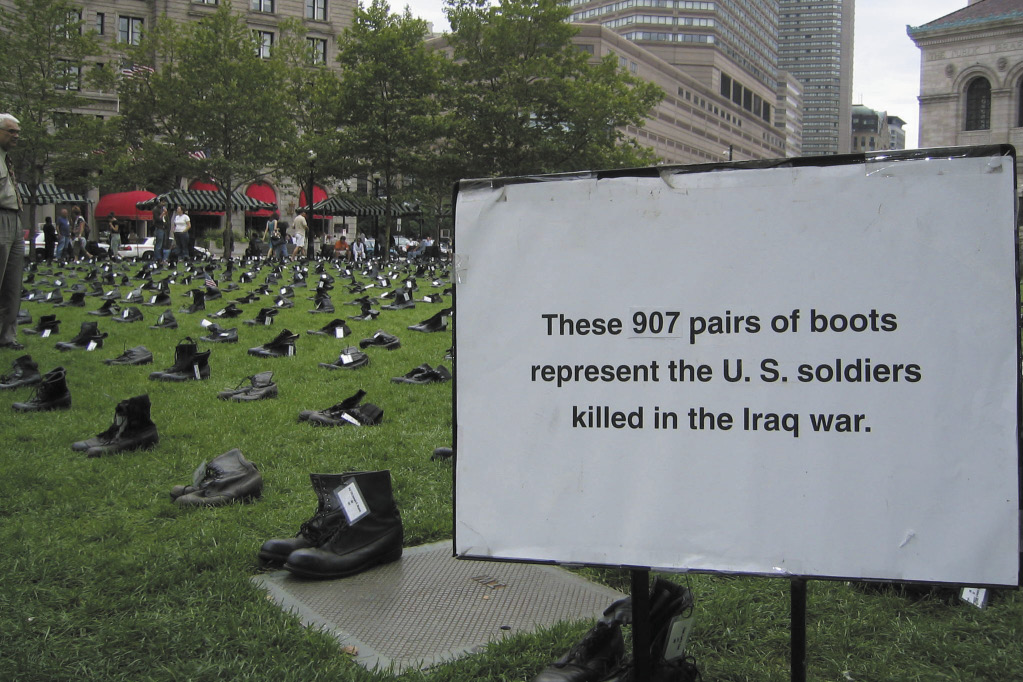
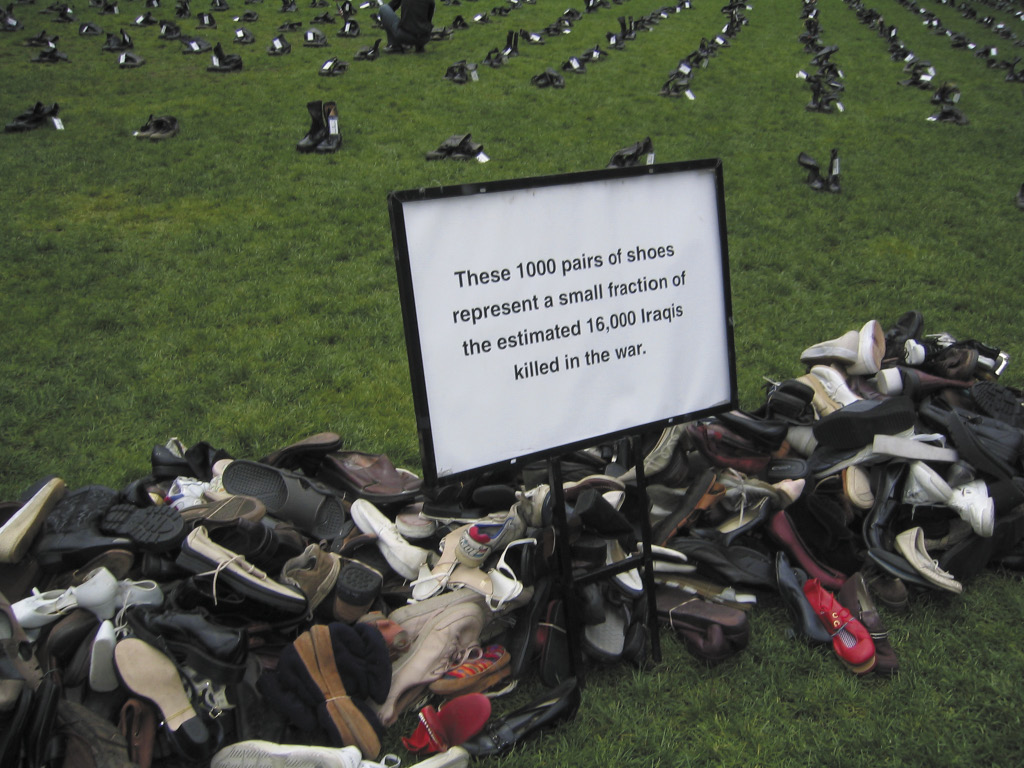
These two photographs are from an exhibition on the Human Costs of the Iraq War by the American Friends Service Committee organised at the National Convention of the Democratic Party in 2004. To what extent do protests like this constrain the US government?
India’s relationship with the US
During the Cold War years, India found itself on the opposite side of the divide from the US. India’s closest friendship during those years was with the Soviet Union. After the collapse of the Soviet Union, India suddenly found itself friendless in an increasingly hostile international environment. However, these were also the years when India decided to liberalise its economy and integrate it with the global economy. This policy and India’s impressive economic growth rates in recent years have made the country an attractive economic partner for a number of countries including the US.
It is important that we do not lose sight of the fact that two new factors have emerged in Indo-US relations in recent years. These factors relate to the technological dimension and the role of the Indian-American diaspora. Indeed, these two factors are interrelated. Consider the following facts:
-
The US absorbs about 65 per cent of India’s total exports in the software sector.
-
35 per cent of the technical staff of Boeing is estimated to be of Indian origin.
-
300,000 Indians work in Silicon Valley.
-
15 percent of all high-tech start-ups are by Indian-Americans.
All this sounds like a lot of jealousy. What is our problem with US hegemony? Just that we were not born there? Or something else?

As soon as I say I amfrom India, they askme if I am acomputer engineer.That feels nice.
Lets Do It
Collect news clippings and articles about the recent Indo-US civil nuclear deal. Summarise the position of the supporters and opponents of the deal.
Like all other countries, India too has to decide exactly what type of relationship it wants with the US in this phase of global hegemony. The choices are not exactly easy. Within India, the debate seems to be around three possible strategies.
- Those Indian analysts who see international politics largely in terms of military power are fearful of the growing closeness between India and the US. They would prefer that India maintains its aloofness from Washington and focuses upon increasing its own comprehensive national power
- Other analysts see the growing convergence of interests between the US and India as a historic opportunity for India. They advocate a strategy that would allow India to take advantage of US hegemony and the mutual convergences to establish the best possible options for itself. Opposing the US, they argue, is a futile strategy that will only hurt India in the long run.
- A third group of analysts would advocate that India should take the lead in establishing a coalition of countries from the developing world. Over time, this coalition would become more powerful and may succeed in weaning the hegemon away from its dominating ways.
India-US relations are perhaps too complex to be managed by a single strategy. India needs to develop an appropriate mix of foreign policy strategies to deal with the US.
Lok Sabha debates Indo-US relations
Here are three extracts from the speeches by the Prime Minister and two opposition leaders during the debate in Lok Sabha on the Indo-US agreement on nuclear energy. Are these three positions in some way linked to the three strategies mentioned in the chapter?
Dr Manmohan Singh, Congress
“Sir, I would respectfully urge this august House to recognise the changed mood of the world towards India. This is not to say that power politics is a thing of the past; that there will never be any attempt to twist our arms. We will protect ourselves to ensure against the risks that are there. But it would be wrong for us not to take advantage of the opportunities that are now on the horizon. I sincerely believe that it is in the interest of our country to have good relations with all the major powers. I make no apology that we seek good relations with the United States. The United States is a pre-eminent power.”
Shri Basu Deb Acharia, CPI(M)
“Since Independence, we have been pursuing independent foreign policy because of our national interest. What have we seen in case of Iraq and in case of Iran? After the July statement, and when there was voting in International Atomic Energy Agency, we found that we sided with the United States of America. We supported the resolution moved by US and P 5. That was not expected before that. When we were trying to bring gas from Iran via Pakistan which we need, we supported America’s stand in regard to Iran. There we find that the independent foreign policy has been affected.”
Maj. Gen. (Retd.) B. C. Khanduri, BJP
“We have also to take note of the fact that today US is — whether we like it or not — the only super power in this unipolar world. But at the same time, we must also remember that India is also emerging as a world power, and a super power. Therefore, we feel that we should have good relations with the USA in the international scenario, but it should not be at the cost of our security.”
How can hegemony be overcome?
How long will hegemony last? How do we get beyond hegemony? These become, for obvious reasons, some of the burning questions of our time. History provides us with some fascinating clues to answer these questions. But what about the present and the future? In international politics, very few factors formally curtail the exercise of military power by any country. There is no world government like the government of a country. As we shall see in Chapter 6, international organisation is not world government. Thus, international politics is ‘politics without government’. There are some rules and norms called the laws of war that restrict, but do not prohibit, war. But few states will entrust their security to international law alone. Does this mean that there is no escape from war and hegemony?
In the short term, we must recognise that no single power is anywhere near balancing the US militarily. A military coalition against the US is even less likely given the differences that exist among big countries like China, India, and Russia that have the potential to challenge US hegemony.
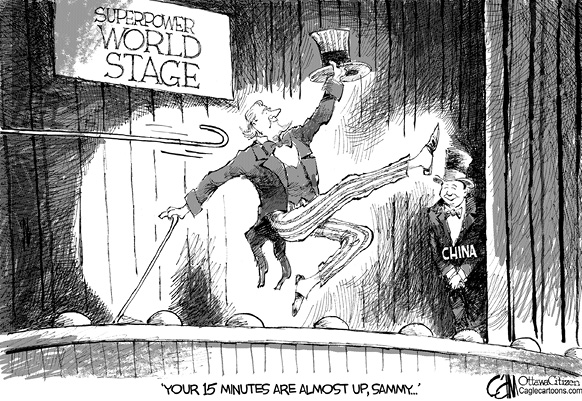
How long do you think the US will stay on the super-power stage? If you were to draw this, who would you show as waiting in the wings?
Some people argue that it is strategically more prudent to take advantage of the opportunities that hegemony creates. For instance, raising economic growth rates requires increased trade, technology transfers, and investment, which are best acquired by working with rather than against the hegemon. Thus, it is suggested that instead of engaging in activities opposed to the hegemonic power, it may be advisable to extract benefits by operating within the hegemonic system. This is called the ‘bandwagon’ strategy.
Another strategy open to states is to ‘hide’. This implies staying as far removed from the dominant power as possible. There are many examples of this behaviour. China, Russia, the European Union—all of them, in different ways, are seeking to stay below the radar, as it were, and not overly and unduly antagonise the US. However, this would not seem to be viable for the big, second-rank powers for very long. While it may be an attractive, viable policy for small states, it is hard to imagine mega-states like China, India, and Russia or huge agglomerations such as the EU being able to hide for any substantial length of time.
Some people believe that resistance to American hegemony may not come from other states, which as we have seen are powerless to confront the US today, but rather from non-state actors. These challenges to American hegemony will emerge in the economic and cultural realms, and will come from a combination of non-governmental organisations (NGOs), social movements, and public opinion; it may arise from sections of the media and intellectuals, artists, and writers. These various actors may well form links across national boundaries, including with Americans, to criticise and resist US policies.
You might have heard the saying that we now live in a ‘global village’. In this global village, we are all neighbours of the village headman. If the behaviour of the headman becomes intolerable, we will not have the option of leaving the global village, because this is the only world we know and the only village we have. Resistance will then be the only option available.
LET'S DO IT TOGETHER
STEPS
- Assign students to major geo-political regions of the world from the vantage point of the US (Central America, South America, Africa, Europe, former USSR, West Asia, South Asia, East Asia and Australia). Alternatively, you could assign students to major conflict zones of the post-Cold War period in which the US was involved. (e.g., Afghanistan, Iraq, Israel-Palestine or Kosovo or any active conflict at the time of teaching).
- Group the students in equal strength according to the number of areas identified. Each group is to prepare a fact-file on the role of the US in these regions or conflicts. The fact-file should focus on the US interest in the region, its activities and the public opinion about the US in the region. Students can also collect and present related pictures/cartoons from all available sources.
- Each group is to present their fact-file before the class.
IDEAS FOR THE TEACHER
Using the fact-file as the background information, the teacher has to refocus on the intervention made by the US and whether these interventions have been in line with the principles advocated by the UN.
Invite the students to reflect on the future of the region or conflict twenty years from now. How long will the US continue to be hegemonic? Which other powers may be in a position to challenge US hegemony in that region?

All this sounds like alot of jealousy. Whatis our problem with UShegemony? Just thatwe were not bornthere? Or somethingelse?
What does history teach us about hegemony?
Given the logic of balance of power, hegemony is a rather unusual condition in international affairs. This is for a very simple reason: in the absence of world government, every state must ensure its own security and, in extreme circumstances, its own survival. Thus, states are acutely aware of power distribution in the international political system, and would not normally allow a single state to become so powerful as to pose a mortal threat to other states.
The balance of power logic of international politics, as outlined above, is amply supported by history. By convention, we regard 1648 as the year in which the sovereign territorial state emerged as the principal actor in world politics. In the over three and a half centuries since then, there have been only two previous occasions when a single state succeeded in gaining preponderance in the system to a similar degree as the US predominates the system today. France from 1660 to 1713 in the context of European continental politics in the first instance of hegemony, Britain with its global maritime empire from 1860 to 1910 is the second.
History also tells us that although at its height hegemony seems formidable, it does not last forever. To the contrary, balance of power politics over time reduces the relative power of the hegemon. In 1660, France under Louis XIV was unchallenged; by 1713, England, Habsburg Austria and Russia were contesting French power. In 1860, the high noon of the Victorian period, Pax Britannica looked secure forever. By 1910, it was clear that Germany, Japan and the US had emerged as contenders to British power. Thus, twenty years from now, another great power, or may be a coalition of great powers could well emerge just as US capabilities are declining in relative terms.
Based on an article by Christopher Layne, “The Unipolar Illusion: Why New Great Powers Will Rise”
EXERCISES
1. Which among the following statements about hegemony is incorrect?
a. The word implies the leadership or predominance of one State.
b. It was used to denote the predominance of Athens in the ancient Greece.
c. The country having hegemonic position will possess unchallenged military power.
d. Hegemonic position is fixed. Once a hegemon, always a hegemon.
2. Which among the following statements is wrong about the contemporary world order?
a. There is an absence of world government, which could regulate the State’s behaviour.
b. The US is the predominant player in world affairs.
c. States are using force against one another.
d. States, which violate international law, are severely punished by the UN.
3. Which among the following statements is wrong with regard to ‘Operation Iraqi Freedom’?
a. More than forty countries joined in the US-led coalition of the willing to invade Iraq.
b. The reason given for invading Iraq was to prevent it from developing weapons of mass destruction.
c. The action was taken with the prior approval of the UN.
d. The US-led coalition did not face major resistance from Iraqi forces
4. Give an example each of the three kinds of hegemony that are dealt with in the chapter. Do not cite examples that are in the chapter.
5. Mention three ways in which US dominance since the Cold War is different from its position as a superpower during the Cold War.
6. Match the following:
i. Operation Infinite Reach
ii. Operation Enduring Freedom
iii. Operation Desert Storm
iv. Operation Iraqi Freedom
a. War against Al-Qaeda and Taliban
b. Coalition of the willing
c. Missile attack in Sudan
d. First Gulf War
7. What are the constraints on American hegemony today? Which one of these do you expect to get more important in the future?
8. Read the three extracts in the chapter from the Lok Sabha debate on the Indo-US deal. Develop any one of these into a full speech defending a certain position on Indo-US relations.
9. “If big and resourceful states cannot resist the US hegemony, it is unrealistic to expect much smaller and weaker non-state actors to offer any resistance.” Examine this proposition and give your opinion
